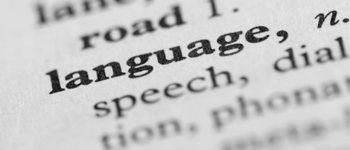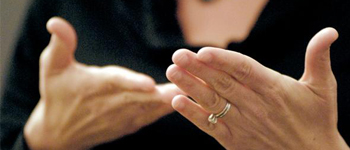History
The Signed Language Interpreting Program at the University of New Mexico (UNM) was established in 1983. Located in Albuquerque, the university is flanked on its west by the banks of the historic Rio Grande and on the east by the Sandia Mountains. Established in 1889, UNM's distinctive architectural style is strongly influenced by the Hispanic and pueblo Indian cultures, and its academic programs recognize the heritage of the Southwest. It has long collaborated educationally with Latin America through efforts that build on complementary strengths. A public institution, UNM is the flagship of the state's university system, and currently serves close to 30,000 students. At the beginning of the millennium it ranks high in terms of research awards from the National Science Foundation, and is in the top fifty Research and Development financial expenditures at public universities.
After the Vocational Rehabilitation Amendments of 1965 and the Rehabilitation Act of 1973, which mandated services for deaf people and prohibited discrimination, the job market for qualified interpreters across the nation began to experience tremendous growth. In Albuquerque, the public schools systems reported an increasing need for signed language interpreters. Hospitals, police, public libraries, private and public businesses and health institutions, and many other places began demanding quality interpreting services. A proposal for an associate of arts degree was presented to the College of Arts and Sciences at UNM in 1979, the same year that the state legislature passed a bill requiring that signed language interpreters be provided within the courts system in New Mexico. The university curriculum committee looked upon this proposal favorably, but requested that it be resubmitted in the form of a baccalaureate degree. Within three years, the interpreting degree was approved by the faculty of the College of Arts and Sciences and in the fall of 1983, fifty-eight students applied for the twelve interpreting major slots allocated to the program (see Lamb & Wilcox 1988 for a complete history). Since its inception the program has graduated more than 300 students with a B.S. degree in Signed Language Interpreting.
The four year interpreting program had originally begun as a series of signed language classes in the Department of Communicative Disorders. When the bachelor of science degree was approved, the program was still housed in the Department of Communicative Disorders. In 1988 the faculty moved the interpreting program to Linguistics, a department that recognized the research potential of American Sign Language. The faculty is currently composed of two full professors, one associate professor and three full-time lecturers, in addition to several temporary part-time instructors. It has a capable staff of a Program Specialist, and a work study student who handle the daily operations of the program.
The UNM Bachelor of Science in Signed Language Interpreting degree has a progressive curriculum of ASL courses spiraling into the interpreter education courses. In its nearly 30 years of operation it has undergone several invigorating revisions to the curriculum. Recently the faculty has begun to implement a Bachelor of Arts in Linguistics with a Concentration in Signed Language Studies. This second undergraduate degree will serve the many students who wish to study ASL, Deaf History, Literature and Culture, but are interested in focusing their studies on linguistics, rather than interpretation.
The entire Signed Language Interpreting Program is housed in the Humanities Building in a centrally located center of 3294 square feet, with a total of nineteen rooms, including faculty and staff offices, social areas, classrooms and meeting rooms, kitchen, restrooms and archives. In addition, there is another new component of the center. a state-of-the-art laboratory for teaching signed language. The signed language lab is situated in the Language Learning Center in Ortega Hall, right next door to the interpreting program in the Humanities Building. This laboratory has 15 bays, each equipped with a QuickTime-capable camera, Macintosh computer, microphone, headset and VCR. Internet video communication is available via computers to link the ASL laboratory with other institutions in the state, nation and throughout the world.
The state and local community is offered two tracks of quality education through the interpreting program: signed language instruction for interested community members, and an interpreter education program that culminates with a bachelor of science degree in interpreting. Approximately 1000 students sign up for the various signed language courses each year. Many students are interested in ASL and signed English classes because they have family members who are deaf (or hard of hearing), or they work with deaf people. Signing skills are also in demand for professionals in fields such as counseling, education, linguistics, speech and language pathology, anthropology, psychology, and so forth. An average of 15 majors are screened into the interpreting education program each spring. Admission into the interpreting program is determined on the basis of the student's previous experiences related to signed language and deaf people, the student's career goals, and scholastic ability. This screening process results in a highly motivated and dedicated group of students. The small size of the program ensures that each student receives considerable individual attention and a rich practicum experience.
The ethnic profile of the program reflects the cultural diversity of the Southwest to some degree; even with an overwhelming majority of Anglo American students applying, there have been approximately 25 percent Hispanics and six percent Asian and Native American students accepted as majors. The faculty strives to encourage ethnic minorities into the program in order to promote a more balanced profession in the region. Although situated within the largest city of the state, the program also endeavors to provide a service to the outlying rural communities.
Having a director of the interpreting degree program who was deaf during the emerging years ensured that the values of deaf people were considered in all areas of the program. The use of interpreters became common place throughout the university and created a widespread, natural acceptance of signed language interpretation. One major benefit of being housed in the Department of Linguistics is the understanding that comes from having the ASL studies run parallel with the Navajo language track. Both languages were transferred into the department in 1988. Navajo transferred from the Modern and Classical Languages department, and Signed Language Interpreting moved from the Department of Communicative Disorders. Navajo is not a "foreign" language; Navajo is indigenous to the United States. However, it is recognized as a foreign language by the University of New Mexico. Many students enroll in Navajo, thereby meeting the "foreign language" requirement of the university. Thus, there is strong acceptance for ASL to meet the foreign language requirement of the College of Arts and Sciences. ASL has been accepted as a foreign language at UNM since 1986.
In 1993, a doctoral degree in linguistics was approved. Graduate students interested in signed language linguistics began considering UNM as a favorable graduate program. Because of the undergraduate signed language courses, graduate students from national and international programs recognized that UNM would be supportive of their desire to include signed languages in their doctoral work. Graduate students and visiting scholars are now researching not only ASL, but also Argentine Sign Language, Brazilian Sign Language (Libras), Catalan Sign Language, Chinese Sign Language, French Sign Language, Italian Sign Language, Persian Sign Language, Saudi Sign Language, and several others. The first dissertation completed in the linguistics doctoral program examined the syntax of ASL. Faculty in the signed language interpreting program work on signed language linguistics and interpreting research in Brazil, China, France, Ireland, Italy, Saudi Arabia, and many other countries.
Thus, the program that began as a one credit course in signed language in 1971 has grown to a program that offers serious linguistic research in signed languages. Undergraduate students have found a place to learn ASL in a formal setting; graduate students from across the world are doing research and presenting their findings on a variety of signed languages.



